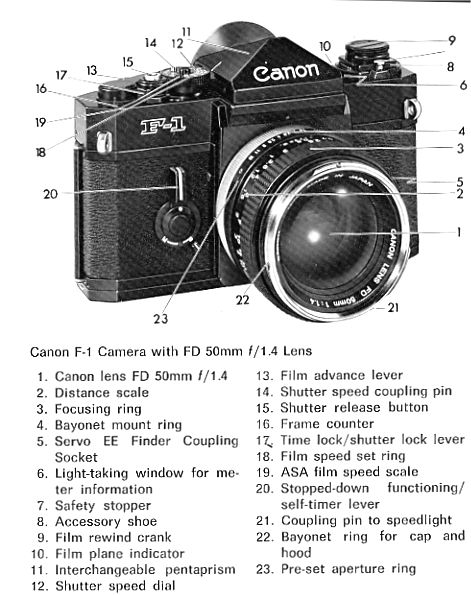

Canon F-1
The most advanced among the Canon single-lens reflex cameras is the Canon F-1. The interchangeability of various parts makes this camera very versatile. The FD series lenses have been developed especially for this camera, thus enabling one to use the through-the-lens meter with the aperture fully open. The FL series lenses allow stopped-down metering. Both types of lens, of course, work automatically. This means that when the shutter is released the lens diaphragm closes automatically from the viewing-focusing aperture (full open) to the premetered aperture, with the metering done through diaphragm fully open, or stopped down. The R series lenses have been developed for the first line of fine Canon single- lens reflex cameras, the Canonflexes. Since the bayonet mount is the same on all Canon SLR cameras, these lenses, of course, can be attached to the recent models also. But because the diaphragm-closing mechanism in the R series lenses is different from that of the FD and FL series lenses, the diaphragm of the R series lenses has to be closed down manually to the premetered f/stop, before the shutter-release button is depressed. The R series lenses, of course, work automatically when attached to any of the Canon-flexes, for which they were originally designed.

The finder system of the Canon F-1 is one of the most versatile of the interchangeable features of this camera. Four different types of focusing screens and four different dioptric adjustment lenses can be attached to each of the five finder systems listed below:
1. The standard pentaprism system, with all the necessary in�formation (f/stop scale, shutter-speed scale, warning marks for improper exposure and out of meter-functioning range, battery check, and fixed dot for diaphragm stop-down metering) visible in the finder.
2. The waist level finder.
3. The speed finder.
4. The Booster T Finder, which extends the range of the ex�posure meter for extreme low light level metering.
5. The Servo EE Finder, which turns the Canon F-1 into a truly automatic electric-eye camera. Wherever the measuring rec�tangle of the finder is pointed, the exposure meter instantly presets the diaphragm-actuating mechanism (via a servo motor) to that correct f/stop, which is required by the previously set shutter speed (shutter speed priority method). When you depress the shutter re�lease button, the diaphragm closes down simultaneously to the f/stop that the exposure meter indicated as correct.
The Servo EE Finder adapts the camera for automatic flash control when the speedlight electronic flash unit is used. After set�ting the film speed, shutter speed, and the guide number, the match�ing needle determines the correct f/stop. This system works with the FD 50mm f/1.4 and f/i.8 and with the FD 35mm f/2 lenses.
Another outstanding feature of the Canon F-i is the provision for motor drive either for single-frame exposures or for high-speed photography at three exposures per second. Of course, the possibili�ties of the motor drive can be best exploited when the long-length roll-film magazine is attached to the camera body instead of the regular camera back. This attachment holds a roll of film of up to 250 exposures.
� Christian Rollinger 2002